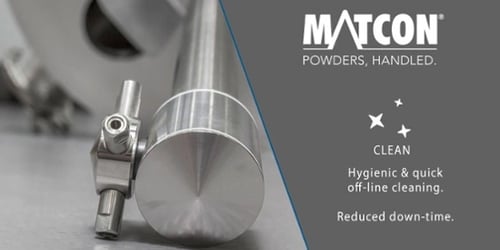When your production line is manufacturing multiple products, the ability to efficiently and effectively clean between batches is imperative.
Traditional powder handling solutions often include fixed lines and static equipment that are complex to clean, resulting in production downtime between batches. An issue easily resolved by investing in an flexible Intermediate Bulk Container (IBC) system.
What is an Intermediate Bulk Container (IBC) System?
An IBC system is a decoupled manufacturing process based around the use of portable, independent containers. These containers – commonly known as IBCs – house the product mix from formulation, through mixing, to packaging. This is achieved by transporting the IBC through the stages of production, keeping all equipment active and therefore enabling multiple batches to be manufactured simultaneously.

How do IBCs improve hygiene? To understand how an IBC system can improve hygiene, it helps to first recognise the major risks posed by using a traditional coupled, fixed line system. By its very nature, a coupled system is difficult to clean. As the elements of the system are static, the entire cleaning process must be carried out in situ, which makes removing any trace of a previous recipe both awkward and difficult to achieve. The main hygiene downfalls experienced by coupled systems include:
Residual product
Product is easily leftover inside the processing equipment, due to the complex and rigid design with hard to reach areas. This makes cleaning and swab testing each surface both challenging and time consuming. To carry out a full clean between batches often means taking all equipment apart, cleaning, drying and re-assembly. This process can take up to eight hours in some cases, which equates to a full shift where the production line is at a standstill.
Cross-contamination
Due to the extended time that process equipment is required to be open to carry out cleaning, they can easily become cross-contaminated by residue from other different processes that are being carried out onsite. Ensuring that cross-contamination doesn’t occur is near on impossible when cleaning must be performed in situ.
Bacterial growth
As difficult as it is to clean a coupled system, the ability to dry equipment after a wet wash can be even more challenging. Those awkward and hard to reach elements to clean, are significantly more difficult to dry, creating the perfect environment for bacteria to grow. If bacteria is present in your system, you put both your product and reputation at risk.
Offline Cleaning without stopping production
An IBC system dramatically reduces the hygiene risks associated with coupled systems, by allowing cleaning to be performed whilst a container is offline and removed from the manufacturing process.
Cleaning is able to take place in a separate controlled environment, where cross-contamination risks are minimal, and all areas of the container are easily accessible, as operators are not having to work around static machinery to gain access.
However, as with any machinery, not all IBCs are as efficient and easy to clean as others. Which is why it’s important to execute an in-depth analysis of the cleaning processes required to maintain a hygienic IBC system, before making your investment.
The Matcon approach to cleaning IBCs
The Matcon IBC Powder Handling System has been designed to ensure that operators are able to easily clean and maintain a high standard of hygiene in their containers. Cleaning can be performed whilst an IBC is offline, in a controlled environment, using manual or automated processes, without losing valuable manufacturing time.
The Matcon IBC Cleaning Module employs both air and wet wash options and can be fully validated for approval by Regulatory Authorities. The air wash capability eliminates the risk of waterborne bacteria growing within your IBC, whilst the wet wash option provides the cleaning power necessary to disinfect containers that have been used for wet mixes. The simple design of the containers, means that drying an IBC after a wet wash is easily achieved, greatly reducing the risk of bacteria building up and effecting products.
Investing in a system that eliminates downtime and minimises the potential for recipe residue, cross-contamination, or bacterial growth, ensures that you are able to manufacture products both efficiently and safely. The Matcon IBC System is able to offer each of these attributes, in an intuitive and hygienic processing solution.
Posted by
Matt BaumberTopics:
IBC System

